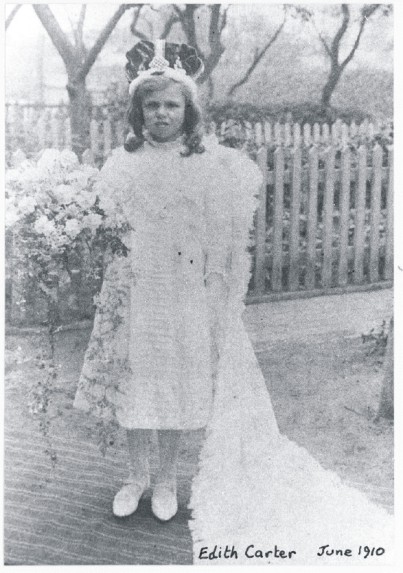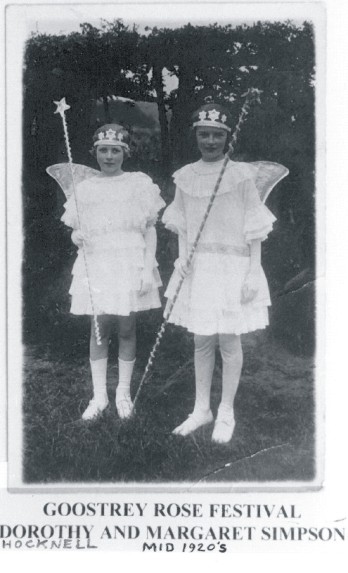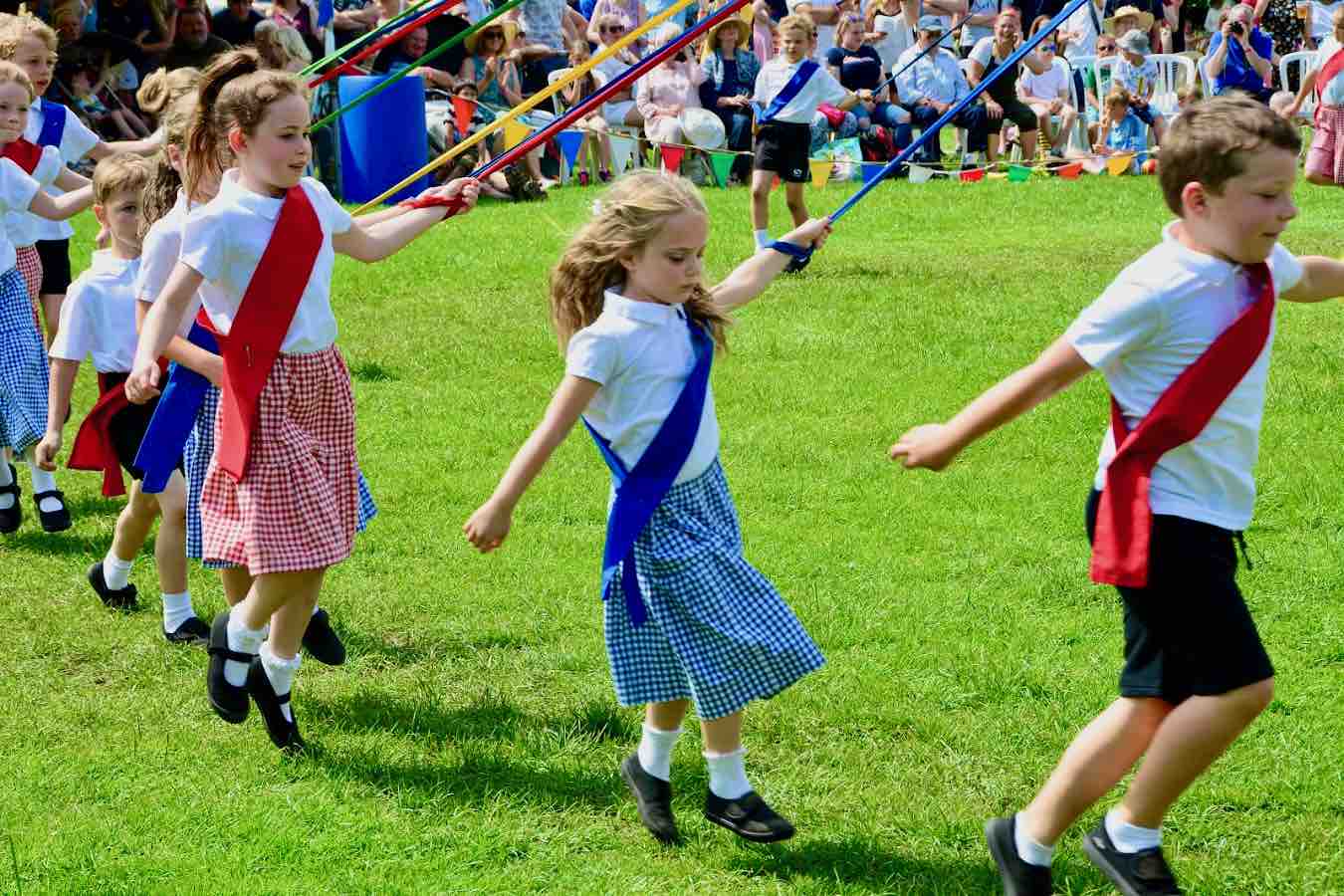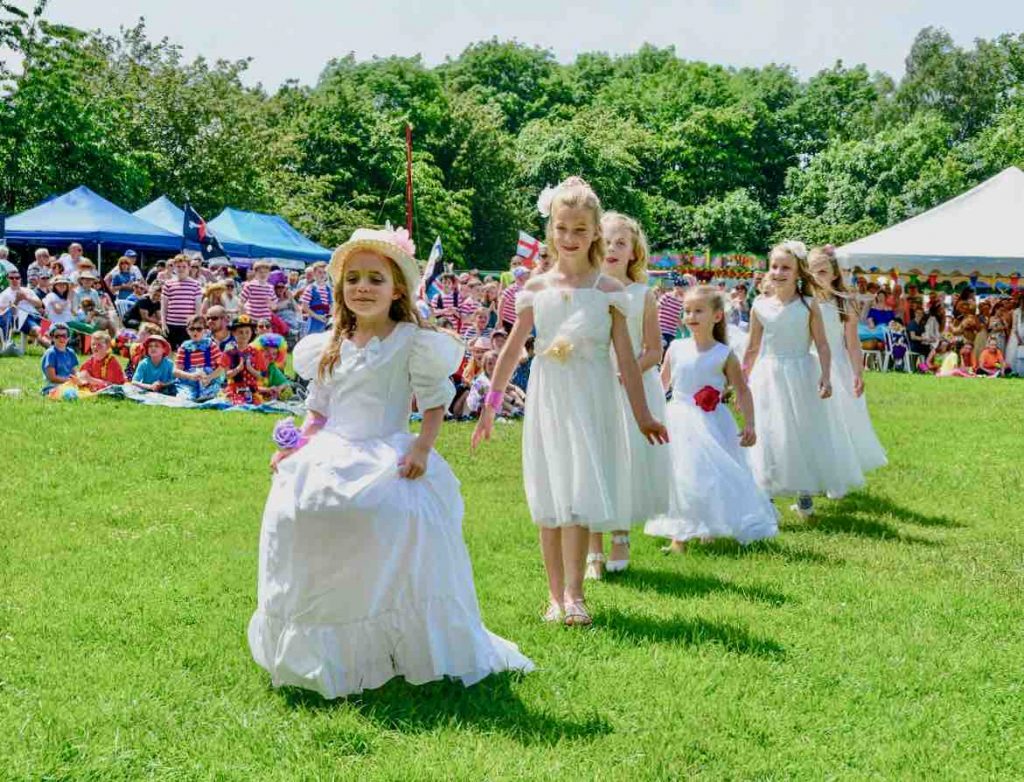History
Learn more about Goostrey Rose Festival through the ages.
The Rose Festival is a day set aside by the Goostrey village community for all children between three years and fourteen years of age. Taking place on the last Saturday in June, it is a significant event in the village calendar; a day of pageantry, with the Rose Queen’s Court, a procession through the village of historical and modern tableau, and of traditional and national dancers. In the past few years has even raised sufficient money to allow donations to various charities, and for the provision of community facilities in the village: the 1966 Rose Festival programme (priced 6d and admission 2/-) stated that:
“The immediate aim of the Village Centre Committee is to purchase land for future Rose Days, School Sports, Field Days, etc. and to plan a Village Hall by 1971.”
The village celebrated its Centenary Rose Festival in 2005 with a spectacular programme which included a gathering of 36 former Rose Queens with a service in St. Lukes Church, and lunch in the Marquee on the field on the Sunday. Other notable visitors in recent years have been pupils from the Elizabeth Fontein Primary School in South Africa (a school twinned with Goostrey Primary School) who have delighted the crowds with displays of traditional dancing.
A traditional village celebration
The history of Goostrey Rose Festival in Goostrey reaches right back to the 1800’s. Miss Beatrice Knowles, the daughter of the landlady of the Red Lion Hotel, and who was the teacher at the village school, was organising “May Celebrations” prior to the turn of the century. The Rose Festival, in its present form, was started by a Miss Emily Cumberbirch and Miss Margaret Worth, the daughter of the landlord of the Crown Hotel. These two ladies financed the day themselves and ended with a total profit of the two old pence – this grand sum being shared between them. In 1901 the census recorded the population of Goostrey as just 351.
The early years
In April 1908 the Goostrey Parish Magazine reported:
“A Dance was held in the School-room in February, organized by the Committee who are undertaking the arrangements for the Children’s May Day Festival this year, which it is proposed to hold, all being well, on the Saturday in Whit Week, June 18th. The object was to raise a small reserve fund in advance so as to insure against any financial loss in the event of a wet day. The Dance was a great success: there being a good company present, and a very enjoyable evening was spent: and the Committee has since had the satisfaction of adding a nice little sum to the May Day Funds”.
Later, in July 1908, the Magazine reported:
“The Committee who organised the Rose Festival had taken an immense amount of trouble in preparing for it and the only thing required to ensure its complete success was a fine summer’s day. Unfortunately that was just the one thing which was lacking. The weather was bitterly cold and very wet. Happily the rain, which descended in torrents later in the afternoon, held off till after the ceremony of crowning had been completed. Emily Cumberbirch, the Rose Queen, looked very nice in her beautiful white robes and with a lovely bouquet of flowers, and was quite a model of grace and dignity. The grouping round the throne of Ladies in Waiting, Maids of Honour, Soldiers, and other Court attendants was very effective. The committee had very wisely decided that it should be essentially a Village Festival and all the different characters were undertaken by young people living in the Parish: even the side shows, the cocoa-nut ‘shy’, shooting gallery, etc., were amateur affairs personally superintended by members of the committee. A great feature, deserving of special praise, was the really excellent dancing by the Morris Dancers, captained by Mr. Aaron Shuttleworth. The limited space at our disposal does not permit the publication of the names of all who took part, but the following were among the principal characters. May Queen: Emily Cumberbirch…. and the accounts showed ……In spite of unfavourable weather…..a financial success…. with Receipts £34. 12s 4d and Expenses £27.2s 3d leaving a balance of £7. 10s 1d, such that the Committee consider that they will be in a position to carry on the Festival next year without making an appeal for subscriptions. They have our best wishes for a prosperous future.”
During the Second World War, a modified form of Rose Festival was held, often with an end object such as the National Savings Campaign. It is interesting to note that in 1940 the committee sent six parcels of “Home Comforts” to serving members of the Forces from the village of Goostrey. An application was also made to the Local Food Officer for a special licence for the allocation of 9 lbs of butter and 18 lbs of sugar for use at the Rose Festival Day. This request was turned down by the official!
Goostrey Rose Festival - 26th June 1976
An example of a typical Rose Festival, the day started for the Queen, Miss Paula Francis, with the adornment of the front door of her home with rose garlands.
The Queen elect then joined the procession, in her landau, accompanied by her train bearers. The procession which set of from Boothbed Lane moved through the village in its traditional order of bands, retiring Queen, floats, Morris dancing troupes and dressed characters.
At the Church the Queen elect performed her first duty by laying a wreath in memory of the dead of the village in the two World Wars and an interdenominational blessing was given.
From here the procession made its way to the Mill Lane field, where the Queen elect was crowned, and the many characters presented to her.
The day continued with the children performing traditional dances, and Morris dancing troupes competing from as far afield as Derbyshire, Lancashire and North Wales, Side shows, teas were also available on the field of festivities and the day culminated in a marquee dance for the village and visiting guests.
Choosing a queen!
Records also exist detailing the selection of the Rose Queen. Miss Marian Marlor was chosen by the children of the Village School in 1907 when she was seven years old. This method of choosing appears to have continued for several years, but the age of girls was varied to between twelve to fifteen years of age. Later all girls in the village between twelve and fifteen years of age were eligible for selection by the Rose Festival Committee. This method was followed by one where girls wishing to be Rose Queen submitted their names to the Secretary of the Rose Festival and a secret ballot was then held among the Committee in April or May, and an Independent Teller was appointed to count the votes and announce the chosen Queen (it was an unwritten rule that committee members did not discuss who they voted for!). That method of election continued until 1956.
More recently the Rose Queen was a 13 year old girl who had participated in three previous Rose Festivals: she was chosen at the Rose Queen Dance held in the Village Hall in February, and more recently on the day of the parties, by an independent panel of Judges who also selected her two Ladies in Waiting.
The main event
The Rose Festival has been held at various venues; Dromedary Farm, about 60 times on the Crown or Hall field situated next to the Old Village Hall opposite the Crown Hotel, on Mill Lane field (School Playing Field) between 1975-85 and since 1986 at the new village hall and field when the Mill Lane field was no longer available. From the Secretary’s minutes of 1953 we find that “….. The setting up of the field is being done on Thursday and Friday nights”; today with the amount of equipment, side shows and marquees involved, this now takes a week of evenings by a large team of volunteers – much the same as it is today!7
Children are very much at the heart of this village event and while in 1948 there were 99 children taking part, by 1976 the total had grown to 350 children. Some of the costumes still used today date back to the early 1900’s, having been made by Mr. Sam Carter in his tailors’ workshop, which was located behind what was, until a few years ago, the old newsagents on Main Road.
The unpredictable nature of our June weather continues to challenge the organisational skills of the committee and the resolve of children and parents alike (as all who were involved in the 2007 Rose Festival will testify!). Although often featured in Rose Festival reports, the weather never seemed to dampen the spirits as can be seen from that early report in 1908. One year the Festival was cancelled through bad weather, and even on that day the sports events, which were a regular feature of Rose Day at that time, commenced at 6pm. Later, in 1982, shortly after the procession started from Booth Bed Lane the heavens opened and costumes, children, spectators and all were thoroughly soaked – the floats nearly floated and the day was a washout! The reaction was a ‘Rose Day Replay’, held on a smaller scale, on the Village Hall field on a beautiful July day a week later.
In 2020, during the COVID-19 pandemic we were unable to celebrate Rose Day in the usual fashion. But it didn’t deter our community from marking the occasion with Goostrey Rose Day at Home. A live account of the event from Dane Sound Radio can be found here.






